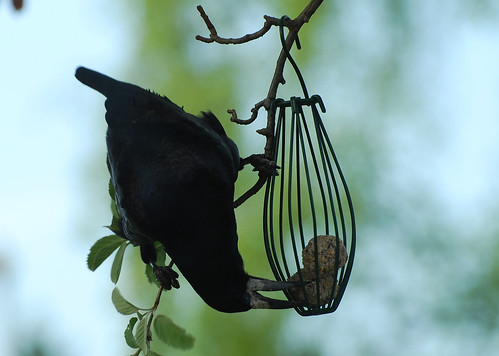You may have noticed that there are few things I like better than getting out into the countryside and taking photographs of the wildlife. But just occasionally the wildlife comes to me and I don’t have to even leave the armchair. Such was my good fortune during a recent visit to my parents.
The garden there is fairly green and the birds know there is always a square meal for them because my Dad has been feeding them regularly for over 40 years. So on this a particular afternoon the feeders were replenished and the birds visited in droves.
 Great tit pair (Parus major, Dansk: musvit) crunching peanuts in the holly bush
Great tit pair (Parus major, Dansk: musvit) crunching peanuts in the holly bush
Because everything was late in the spring this year due to the cold weather the birds were paired off but were not all sitting on eggs yet and various species were behaving as though they were starting to think about mating but hadn’t yet got round to it.
 Collared dove (Streptopelia decaocto, Dansk: tyrkerdue) perched in the laburnum tree waiting for his mate
Collared dove (Streptopelia decaocto, Dansk: tyrkerdue) perched in the laburnum tree waiting for his mate
It was Easter Sunday, March 31st, the leaves of the laburnum tree were just starting to shoot and the thoughts of the collared doves were turning to lurv:
 The good lady duly arrived and bonds were reaffirmed
The good lady duly arrived and bonds were reaffirmed
The Danish name for the collared dove ‘tyrkerdue‘ translates to ”Turkish dove‘ in English because their home territory is in Turkey and the Middle East from where they spread to the UK, arriving in 1955. The gentle and peaceful image traditionally associated with doves is belied by the reality, they are one of the most agreesive garden birds and I’ve watched them chase off all comers including much bigger birds than themselves such as wood pigeons. They’re feisty characters!
Ten days before this visit to my folks I’d seen siskin (Carduelis spinus, Dansk: grønsisken) in my garden near Cambridge and I talked about them in this post. So within the space of a couple of weeks I saw them in two gardens, having never seen that at all before. Another sign that times they are a-changing, climatically speaking. This one is sat just above a niger seed feeder which is what tempted it into the garden in the first place.
Much to the annoyance of my Dad a flock of 20-30 feral pigeons have taken up residence on an adjacent roof and as with other pigeons they have an insatiable appetite for free food. As they are mob-handed and not slow in coming forward they deter the smaller songbirds so I can fully understand the old boy’s ire, but on the other hand they are handsome birds and entertaining to watch as a flock in flight.
And then this little guy turned up:
I don’t know what happened to him but I’ve heard it said that robins (Erithacus rubecula, Dansk: rødhals) will fight each other to the death in competition for mates, and peck at each others heads to the point where they scalp each other. So I wonder if this little monster has been fighting and got a sub-lethal pecking that subsequently became infected. Whatever it was, it didn’t kill him and he was turning up in my folk’s garden for a couple of months in this state before he eventually disappeared.
















 Greenfinch (Carduelis chloris, Dansk: grønirisk)
Greenfinch (Carduelis chloris, Dansk: grønirisk)
































